Abstract
Due to the classification of Co as a CMR (carcinogenic, mutagenic, toxic to reproduction) as well as the classification of both Co and WC as CRM (critical raw materials) more and more research is being carried out to investigate possible substitutes for WC-Co hardmetals. To directly compare their microstructure as well as mechanical and thermophysical properties, five very different hardmetals were investigated. For this purpose, the compositions WC-Co, WC-FeNiMn, WC-HEA, NbC-Co and HEC-Co were selected in order to investigate alternative binders for cobalt as well as different alternative hard phases for WC. The results of the hardness measurements showed that for the hardmetals with alternative binders (WC-FeNiMn and WC-HEA) hardness values of 1327 HV10 and 1299 HV10 comparable to WC-Co with 1323 HV10 can be achieved. When WC is replaced by HEC as the hard phase, a significantly higher hardness of 1543 HV10 can be obtained, demonstrating the great potential of high-entropy carbides. Furthermore, the hot hardness measurements between RT and 900 °C showed significantly higher values (up to approx. 290 HV10) for the WC-HEA and HEC-Co hardmetals compared to those of WC-Co. However, the fracture toughness of the alternative hardmetals was lower compared to that of conventional WC-Co hardmetals. In terms of thermophysical properties, the results of the hardmetals with alternative binders were close to those of WC-Co. Thus, it can be shown that it is possible to produce alternative hardmetals with comparable properties to WC-Co and that with further optimization they show great potential to replace WC-Co in the near future.
1. Introduction
Since hardmetals were invented by Schröter and Prof. Skaupy in the 1920s [1], it has been clear that the marriage between tungsten carbide (WC) and cobalt (Co) is something special. The combination of high hardness and high toughness is unique, and essential in the machining industry. Due to the magnetic properties of cobalt, it is also possible to perform non-destructive characterization by using different magnetic parameters of the hysteresis curve. Unfortunately, regarding increasing material shortage around the globe and geopolitical problems, WC and Co have been classified as critical raw materials (CRM) [2]. Furthermore, cobalt is also classified as a carcinogenic-mutagenic and toxic to reproduction material (CMR) [3]. This classification has led to more and more safety precautions to be implemented in hardmetal processing industries. Therefore, the urgency to find a worthy alternative with comparable or even better characteristics increases. In recent years, the number of research activities regarding the substitution of WC-Co has increased significantly. On the one hand, there is research and applications of so-called cermets, in which WC is partially or completely replaced by alternative carbides or carbonitrides. Here, TiC, TiCN and NbC were successfully used as novel hard phases and partially tested in use. In recent years, there have also been studies on different high-entropy carbides (HEC) as alternatives have increased in the field of hard phases [4,5,6,7,8,9,10,11,12,13,14,15]. Particularly regarding NbC- and HEC-based hardmetals, there is still some research to be done to determine the full potential of these alternative carbides for hardmetals. Woydt et al. have shown the high potential of NbC-based hardmetals for use as cutting tools and for wear protection but produced the samples with SPS (spark-plasma sintering), which cannot yet be used in industry [14,15]. Due to advent of HEC-based hardmetals, Pötschke et al. could demonstrate the possibility of producing dense HEC-based hardmetals using industrial-related furnaces [4]. This work will investigate important properties to analyze the further potential of a selected HEC hardmetal from the work of Pötschke et al. [4].
On the metal binder side, there is already a lot of research into substituting cobalt. Among pure metals, only the metals next to Co in the PSE-positioned elements, nickel (Ni) and iron (Fe), seem suitable. However, their mechanical properties in WC-based composites are inferior to those of WC-Co [16,17,18,19,20]. Thus, currently more and more research is focused on adjusted Ni- and Fe-based alloys with small additions of other metal elements [21,22,23,24,25]. Furthermore, high-entropy alloys (HEA) have gained interest in recent years, although Co is often still used as an alloying partner [26,27,28,29,30]. Even if some research has already demonstrated the high potential of Fe- or Ni-based and HEA binders, one of the main problems is the reduced carbon window and the formation of unwanted phases [26,31].
However, no alternative system has yet been found that could completely replace WC-Co. To better understand and optimize possible alternative material systems, further investigations are necessary. In this work, four different, alternative hardmetals (WC-FeNiMn, WC-HEA, NbC-Co, HEC-Co), as well as a comparative variant made of WC-Co, are investigated (Figure 1). For this purpose, the mechanical, thermophysical and magnetic properties of the different hardmetals are compared with each other because these properties are highly relevant for the production, quality control and application of these materials.

Figure 1.
Schematic visualization of the investigated hardmetals.
2. Materials and Methods
The powders used to produce the different hardmetals can be seen in Table 1. The powders were mixed with a standard mixing and milling process. All mixtures had the same binder content of 16 vol.%. For the hard phase, WC, NbC and HEC powders with similar grain sizes were used. The high-entropy carbide used was synthesized according to the vacuum sintering profile described in [32]. After the milling process, the mixtures were uniaxially pressed and sintered in a SinterHIP (SinterHIP furnace, FCT Anlagenbau, Sonnenberg, Germany) at 1350 °C for WC-FeNiMn, at 1400 °C for WC-Co/HEC-Co and at 1450 °C for WC-HEA/NbCo. The holding time at the sintering temperature was 45 min for all hardmetals in an atmosphere of Ar and at a pressure of 100 bar. During the mixing and milling process, paraffin was added as a pressing aid, 2.5 wt.% for HEC-Co, 3.5 wt.% for NbC-Co and 2.0 wt.% for all others. Before sintering, debinding was performed in the same process, at a temperature of 400 °C for 60 min under a reducing H2 atmosphere.

Table 1.
Overview of raw materials used for the production of the investigated hardmetal systems.
After the sintering process, the density of the specimens was measured according to Archimedes’ principle using ISO 3369 [33] with a Mettler Toledo AT261 balance (Mettler-Toledo, Columbus, OH, USA). The magnetic properties, magnetic saturation (mS) and coercivity (Hc) were determined with a SETARAM Sigmameter S60 (KEP TECHNOLOGIES SA, Mougins, France) and a FOERSTER Koerzimat 1.097 HCJ (Institut Dr. Foerster GmbH & Co. KG, Reutlingen, Germany) according ISO 3326 [34]. For the investigation of the microstructure, an optical light microscope ZEISS Axioscope 7 (Zeiss Ltd., Oberkochen, Germany) and a field emission scanning electron microscope, FESEM (ZEISS CrossBeam, Zeiss Ltd., Oberkochen, Germany), was used. The phase composition of sintered hardmetals was analyzed with an X-ray diffractometer with Cu-Kα radiation (Bruker D8 Advanced, Bruker AXS, Karlsruhe, Germany) and an energy dispersive X-ray spectroscope (EDS). For FESEM and EDS analysis, polished embedded and lite silver-contacted specimens were used and during EDS, a drift correction was applied. Hardness (HV10) and fracture toughness (K1C) were measured with a KB 30 S hardness tester (KB Prüftechnik GmbH, Hochdorf-Assenheim, Germany) according to ISO 3738 [35] and using the Shetty formula [36]. Hot hardness at different temperatures was determined with a custom-built high-temperature hardness testing system (Hegewald & Peschke Meß- und Prüftechnik GmbH, Nossen, Germany). To analyze the sintering shrinkage and outgassing behavior under an inert atmosphere (Argon or Helium), a NETSCH Simultaneous Thermal Analyzer STA 429 and a NETZSCH Thermodilatometer 402/ES (NETZSCH-Gerätebau GmbH, Selb, Germany) were used (DIN 51007 [37]). The heating rate was 10 K/min. Heat capacities at room temperature were determined according to DIN EN 821-3 [38] with a Perkin-Elmer Differential Scanning Calorimeter DSC 7 (PerkinElmer Inc., Waltham, MA, USA) and the thermal diffusivities according to DIN EN 821-2 [39] by a NETZSCH light flash analyzer, the LFA 447 (NETZSCH-Gerätebau GmbH, Selb, Germany). The electrical conductivities were determined using five (32 × 5 × 4 mm3) samples with the 4-point probe method using a Keithley 199 DMM (Keithley Instruments, Cleveland, OH, USA) with a Voltcraft VLP-2403Pro power source (Conrad Electronic SE, Hirschau, Germany).
3. Results
3.1. Microstructure and Mechanical Properties
Microstructures of all produced and studied hardmetals are shown in Figure 2, where the dark gray phase represents the hard phase, and the light gray phase represents the binder phase. At the first glance, the biggest difference was the much coarser grain size of the hard phase in the case of NbC-Co. Since the grain size plays an important role in some mechanical and thermophysical properties, the results for NbC-Co can thus not be directly compared with those of the other hardmetals. In contrast, the grain sizes of the WC-Co, WC-FeNiMn, WC-HEA and HEC-Co were quite comparable. However, WC-FeNiMn, WC-HEA and NbC-Co showed a higher degree of porosity after sintering. The results of XRD-analysis (also in Figure 2) showed no presence of an unwanted phases like the well-known “eta” phase, which is a brittle carbide phase (M6C/M12C), or any intermetallic phase, which would deteriorate mechanical properties such as fracture toughness or bending strength. However, comparing only hardmetals with Co as a binder, different cobalt phases formed. Most Co-based hardmetals showed only the cubic cobalt phase, but for the NbC-based hardmetal, the hexagonal cobalt phase was also prominent. For the coarser NbC hardmetal, it was unclear if these changes happened due to sample preparation, larger free-path length of the Co phase, or due to a less alloyed binder phase, which then more easily transformed to the thermodynamic, more stable hexagonal Co phase. The sample with HEC-Co seemed to have some tungsten and/or titanium dissolved in the cobalt binder, since a shift of the reflex positions of the cobalt phase was seen. Considering the studied binder phases, FeNiMn in Figure 2b and HEA in Figure 2c as well as the hard phase HEC in Figure 2d show no specific reflex positions could be found in the PDF database. By matching similar alloys from the elements used here, the reflections were assigned to the respective fitting, more complex alloys. The PDF cards used are listed in Table 2.
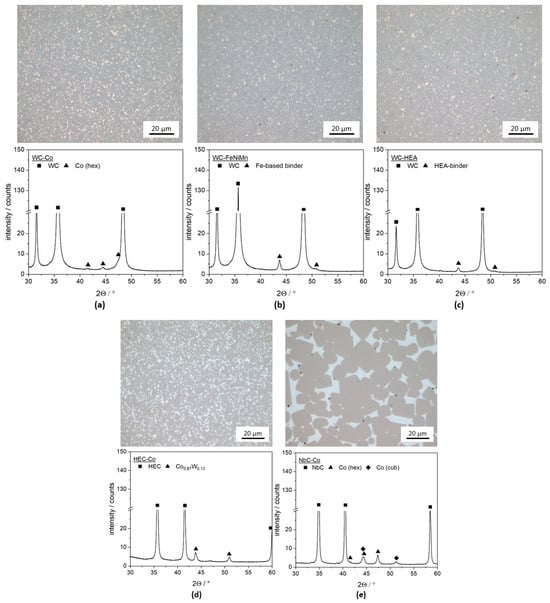
Figure 2.
Optical microscopy and XRD analysis of the different hardmetals. (a) WC-Co; (b) WC-FeNiMn; (c) WC-HEA; (d) HEC-Co; (e) NbC-Co. (dark gray phase = hard phase; light gray phase = binder phase).

Table 2.
Detected phases, corresponding crystal structures, assigned PDF cards and used XRD analysis results in Figure 2.
More details of the microstructures of the different hardmetals are shown in FESEM images in Figure 3. Because we used a phase contrast detector (BSED), the hard phase is represented here by the light gray phase due to a higher atomic number of the hard phases compared to the binder represented through the dark gray phase. The microstructures of WC-Co/-FeNiMn and -HEA look quite similar. The WC grains have sharply defined edges, whereas the NbC and HEC grains are more rounded. The grain size of all hardmetals except NbC-Co are comparable, with average grain sizes of roughly 2–3 µm. As in XRD, no unwanted phases could be identified.
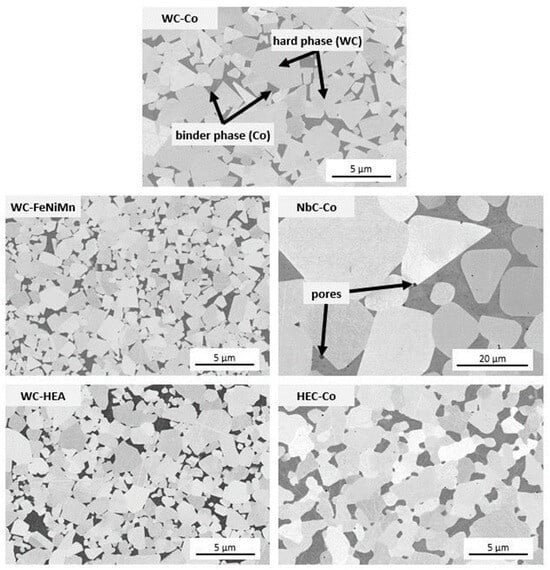
Figure 3.
FESEM images of microstructure of different hardmetals, BSED contrast mode.
The results of the EDS analysis are presented in Figure 4, Figure 5, Figure 6, Figure 7 and Figure 8. Area analyses are shown over the entire range of the microstructure under consideration, designated as composite (Spectrum 1), and several point or area analyses are shown for the respective hard phase as well as for the binder phase. The homogeneity of the compositions can be well shown with the measurement at several points and the overlapping of the spectra. In each hardmetal, a small amount of oxygen was detected. However, since neither microstructural examinations nor XRD analyses revealed the presence of an oxide phase, it is very likely that the low oxygen content was an artefact from the preparation.
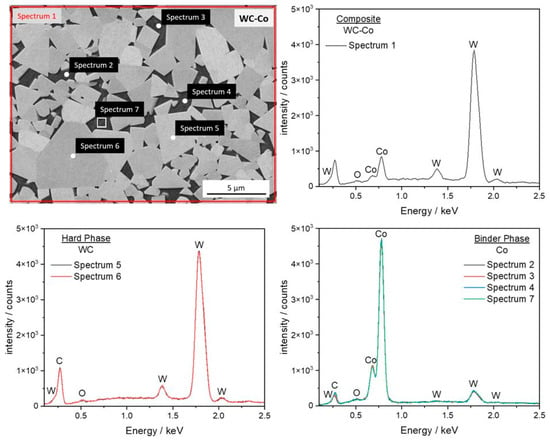
Figure 4.
EDS analysis of WC-Co.
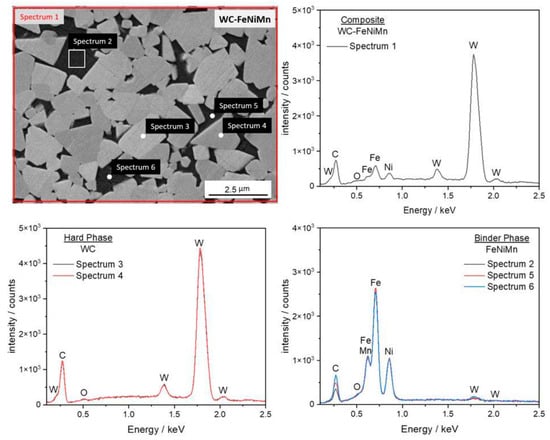
Figure 5.
EDS analysis of WC-FeNiMn.
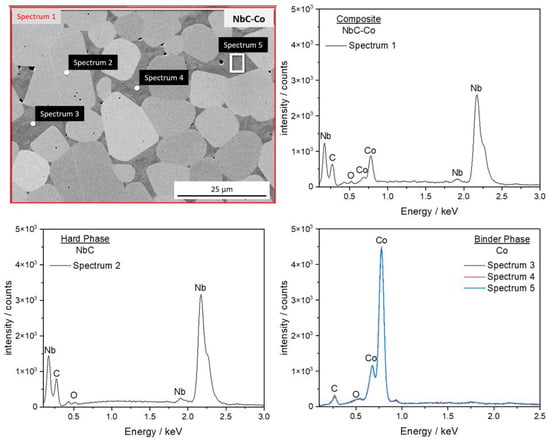
Figure 6.
EDS analysis of NbC-Co.
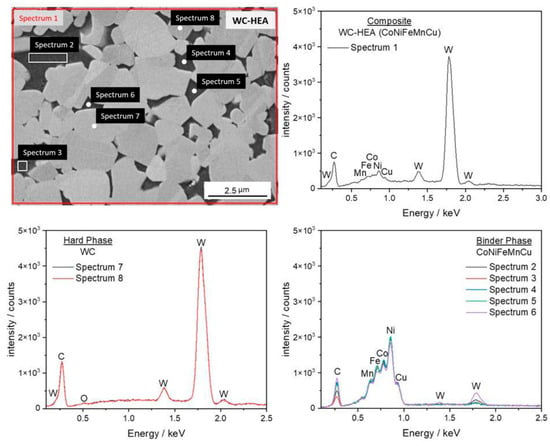
Figure 7.
EDS analysis of WC-HEA.
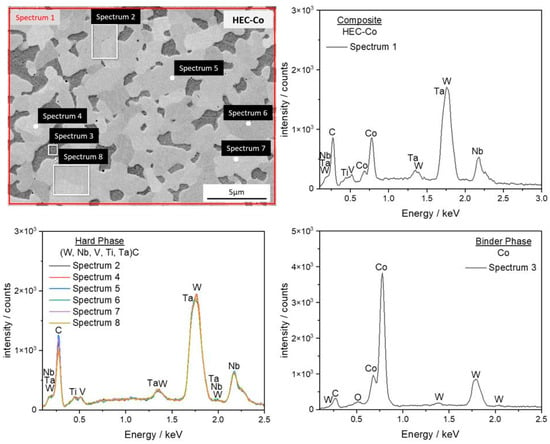
Figure 8.
EDS analysis of HEC-Co.
Since no segregation of the more complex HEA and HEC phases (Figure 7 and Figure 8) could be detected via the EDS analyses either, or any other undesirable phases, these results reflect well those of the previous microstructure and XRD analyses.
Results of the hardness and fracture toughness are presented in Figure 9a. The hot hardness measurements at room temperature show an offset of approximately +50 to +80 HV10 compared to the measured values in Figure 9a. However, this deviation can be attributed to a systematic error caused by the use of different devices for the hardness measurements. Thus, the curves of the hot hardness measurements can be compared. The WC-Co sample provides the best combination of hardness and fracture toughness. The hardmetals WC-FeNiMn and WC-HEA had a similar hardness, but a lower fracture toughness. The highest hardness but also the lowest fracture toughness was measured for HEC-Co. NbC-Co showed the lowest hardness and second-lowest fracture toughness, which is most likely due to the coarser grain size [6,40,41]. Consequently, NbC-Co also had the lowest hardness values for hot hardness, shown in Figure 9b. Likewise, even at higher temperatures, HEC-Co showed the highest hot hardness values followed by WC-HEA. WC-Co and WC-FeNiMn showed comparable hot hardness values up to a temperature of 400 °C. At higher temperatures, the values of WC-Co approached those of WC-HEA.
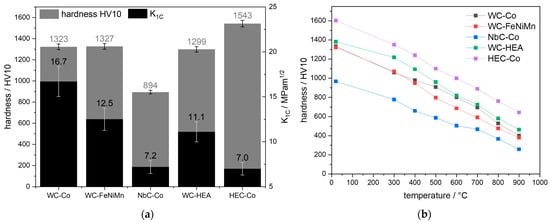
Figure 9.
(a) Hardness HV10 and fracture toughness; (b) hot hardness HV10 from RT to 900 °C. The error bars represent the measurement uncertainty (±2% for hardness and ±10% for fracture toughness).
3.2. Thermophysical Properties
In addition to understanding the differences in the mechanical properties, it was also important to better understand their different thermophysical behaviors. Since some thermophysical properties depend on the grain size, the results of NbC-Co were not directly comparable with those of the other carbides, due to its coarse NbC grain size. Table 3 provides an overview of some results of the thermophysical and magnetic properties of the samples.

Table 3.
Measured density, magnetic and physical properties of the sintered hardmetals.
In order to characterize the difference in the sintering behavior of the different hardmetals, thermodilatometry and thermogravimetry measurements were carried out. In Figure 10, the results of the thermodilatometry show the length change behavior during the sintering process. Interestingly, the shrinkage of the HEC-Co hardmetal already began between 700 °C and 1050 °C, but for all other hardmetals the shrinkage started between 900 °C and 1000 °C. For WC-Co, WC-FeNiMn, WC-HEA and HEC-Co, the main shrinkage occurred between 1100 °C and 1250 °C. For NbC-Co, the main shrinkage happened at significantly higher temperatures of 1250 °C to 1400 °C. The shrinkage almost ended at 1320 °C for WC-Co and WC-FeNiMn, but for the other hardmetals shrinkage was not finished up to 1430 °C.
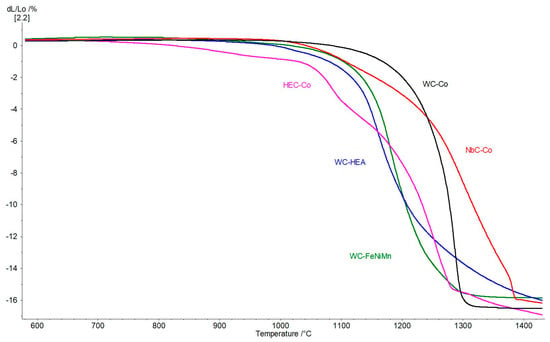
Figure 10.
Length change behavior during sintering measured by thermodilatometry.
The mass change along the temperature of outgassing and sintering is presented in Figure 11. HEC-Co showed the highest mass change rate between 700 °C and 1100 °C and one of the highest mass losses at approximately 1100 °C. Furthermore, NbC-Co showed a significant mass loss, mainly through outgassing of carbon monoxide, up to highest temperatures. Outgassing processes for WC-Co, WC-FeNiMn and WC-HEA ended at a temperature of approximately 1000 °C. The different additions of paraffin as a pressing aid caused a visible difference in the loss of mass after the debinding phase <600 °C; for the samples HEC-Co and NbC-Co, 2.5 wt.% paraffin and 3.5 wt.% paraffin was used, respectively.
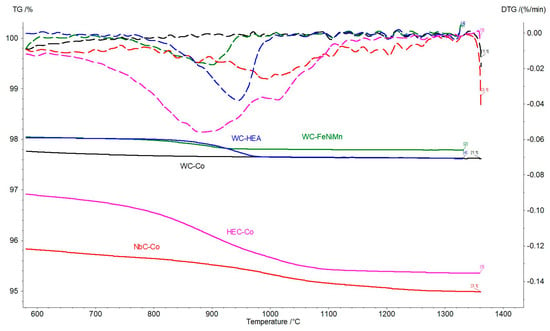
Figure 11.
Mass change behavior during sintering and outgassing measured by thermogravimetry (mass: TG, straight lines; mass change rate: DTG, dashed lines).
Using magnetic saturation (mS) and coercivity (Hc) is well known as a non-destructive characterization method for controlling the binder content, grain size and presence of unwanted phases in the microstructure (eta phase/free carbon). The results of the magnetic saturation and coercivity measurements in Table 3 and Figure 12a reveal that for some hardmetals, this common characterization method can no longer be used. WC-FeNiMn showed no magnetic saturation, due to its mostly austenitic nature [42]. In contrast, NbC-Co had the highest magnetic saturation and the lowest coercivity. The mS and Hc values of WC-Co and HEC-Co were quite comparable, while WC-HEA showed lower values.

Figure 12.
(a) Magnetic saturation and coercivity; (b) density and heat capacity. The error bars represent the measurement uncertainty (±0.3 µTm3/kg for magnetic saturation; ±0.1 kA/m for coercivity; ±0.01 g/cm3 for density; ±3% for heat capacity).
With a different elemental composition of the hardmetals came a change in density and heat capacity. Figure 12b shows the values for the investigated hardmetals. The hardmetals with only WC as a hard phase showed the highest density and the lowest heat capacity. In contrast, NbC-Co had the lowest density and highest heat capacity.
The results of heat conductivity and electrical conductivity measurements are given in Figure 13a. WC-Co reached the highest values for these measurements as well as for thermal diffusivity, shown in Figure 13b. The values for the hardmetals WC-FeNiMn and WC-HEA were comparable, suggesting that both electrical and thermal conductivity are mainly influenced by the hard phase WC. The hardmetals with another hard phase, NbC-Co and HEC-Co, showed lower values, with those of HEC-Co being the lowest.
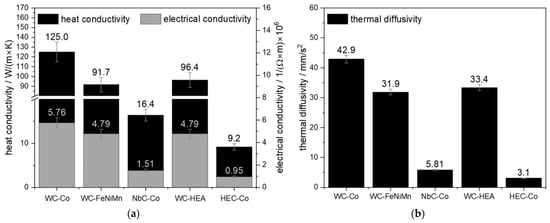
Figure 13.
(a) Heat conductivity and electrical conductivity; (b) thermal diffusivity. The error bars represent the measurement uncertainty (±8% for heat and electrical conductivity; ±3% for thermal diffusivity).
4. Discussion
Microstructure and phase analyses of studied hardmetals confirmed that for all hardmetals, the targeted two-phase compositions were achieved. No dissolution of the more complex phases HEA and HEC occurred either. All hardmetals except NbC-Co showed comparable grain sizes. Even though the microstructures showed that for NbC-Co, an addition of a grain growth inhibitor would be needed to avoid coarse grains, the composition was nevertheless used for this study.
With the substitution (also partially) of WC, the fracture toughness noticeably decreased. However, the investigated HEC-Co achieved a significantly higher hardness compared to the other grades. With further research in regard to the investigated HEC, an enhancement of the interface between the HEC and binder and with investigation regarding different binder systems, the fracture toughness could be increased. Pötschke et al. [43] have shown already that when using Ni, the fracture toughness can be increased significantly. The samples with WC-FeNiMn and WC-HEA achieved a fracture toughness close to that of the WC-Co reference material. Comparing the grain size between WC-Co, WC-FeNiMn and WC-HEA, the reference WC-Co (Figure 3) showed a slightly larger grain size, which may be responsible for the higher fracture toughness. Likewise, the samples with alternative binders showed a certain residual porosity. If the remaining porosity can be eliminated with further research, it is thought the mechanical properties may increase as well.
HEC-Co showed the highest values in hot hardness up to temperatures of 900 °C, which shows the great potential of this material. The WC-HEA also showed, especially between RT and 500 °C, higher hardness values, followed by WC-Co and WC-FeNiMn. This suggests that the HEA binder has visibly better hardness properties up to 500 °C. Explanations for this could of course be the high disorder and stability of alloy partners or because of a slightly smaller average WC grain size as compared to the WC-Co reference material [28]. WC-FeNiCo also showed a slightly smaller average WC grain size as compared to WC-Co, and showed lower hot hardness values over the whole temperature range.
The results of thermodilatometry and thermogravimetry showed how the sintering and outgassing of WC-Co is influenced when the hardmetal composition is changed. Additional elements (HEC-Co, WC-HEA, WC-FeNiMn) within the hardmetal composition shifted the sintering to lower temperatures. The shrinkage due to sintering of NbC-Co started at lower temperatures and finished at higher temperatures than the sintering of WC-Co. Outgassing due to the reaction of oxides or hydroxides (for instance, on the particle surfaces) with carbon or carbides is expected in the temperature range between 600 °C up to highest temperatures. Carbon dioxide, carbon monoxide or water is formed, and mass loss is detected. Higher mass losses were noted for more complex hardmetals and NbC-Co in comparison to WC-Co. This information can be used for optimization of the outgassing and sintering temperature-time cycles. The aim should be to finish gas reactions before closing open porosity during sintering. Thus, porosity can be avoided or reduced.
Using elements other than W, C and Co, magnetic properties could be different or could lead to no magnetic properties at all. WC-FeNiMn showed nearly no magnetic properties. The reason for this was the forming of an austenitic iron binder phase which was not magnetic. Moreover, Ni and Mn are well known austenite stabilizers. Therefore, for this kind of hardmetal, a new characterization method using other material properties must replace the classical methods. The reason why WC-FeNiMn had the highest Hc value could be the very thin ferritic iron layers which would lead to very low magnetic properties and a higher force (Hc) being needed to demagnetize the samples. The magnetic saturation of WC-HEA is also lower than for WC-Co, due to the addition of alloy partners with nonmagnetic properties. For these kinds of new hardmetals, the new correlation between coercivity und magnetic saturation must be investigated first, before these parameters can be used for quality classification.
Comparing the different results for the heat capacity and density of the hardmetals, it is clear that using other elements and compositions produces a change in density and heat capacity. Hardmetals with WC as hard phase still had a comparable density and heat capacity. However, with the substitution of WC with other hard phases, the density became lower, and the heat capacity in turn higher. The reason was the relatively high density and low heat capacity of WC in comparison to NbC and (WVNbTiTa)C. In the literature, there is hardly any information on thermophysical properties of hardmetals, and if there is, it is mostly for WC-Co [44].
The results of the heat conductivity, thermal diffusivity and electrical conductivity were mostly influenced by the type of hard phase used. For pure WC hardmetals, the values were noticeably higher. The different binder composition of the hardmetals WC-FeNiMn and WC-HEA could have had a small influence, which means that the values for these were slightly smaller compared to those of WC-Co. Furthermore, the heat conductivity depends mainly on the thermal diffusivity, whereby the heat conductivity is the product of density, heat capacity and thermal diffusivity. Interestingly, it should be emphasized that for WC-FeNiMn and WC-HEA, heat conductivity with values of almost 100 W/(m×K) could still be achieved.
5. Conclusions and Outlook
The comparison of the investigated properties of the five selected hardmetal grades with different alternative binders and hard phases showed that although no equal successor to WC-Co has yet been found among them, it is apparent that WC-FeNiMn and WC-HEA already produce properties fairly close to the here investigated properties of WC-Co. The hardness values of WC-FeNiMn with 1321 HV10 and WC-HEA with 1299 HV10 were comparable to the hardness of WC-Co with 1323 HV10. However, their fracture toughness of 12.5 MPam1/2 (WC-FeNiMn) and 11.1 MPam1/2 (WC-HEA) was still lower than that of WC-Co with 16.7 MPam1/2. The hot hardness curves of WC-HEA showed even higher hardness than WC-Co up to 900 °C. HEC-Co had the highest hardness with 1543 HV10 and noticeably higher hot hardness values up to 900 °C in comparison to the other materials, while having a similar grain size. This confirms the high potential of such high-entropy-based hard phases. Furthermore, the heat and electrical conductivity values of WC-FeNiMn with 91.7 W/(m×K) and 4.79 1/(Ω×m)×106, and of WC-HEA with 96.4 W/(m×K) and 4.79 1/(Ω×m)×106, were close to the values of WC-Co with 125 W/(m×K) and 5.76 1/(Ω×m)×106. To avoid the pores in WC-FeNiMn and WC-HEA, an optimization of the sintering conditions, mainly outgassing time and temperature or sintering time and temperature.
Another challenge with some of the new hardmetal variants will be the necessary adaptation or replacement of the non-destructive quality analysis via the magnetic properties, as some of the new potential alternatives to WC-Co showed reduced magnetic properties or none at all.
In summary, the results obtained here provide information to improve potential alternatives to WC-Co and also show their great potential for possible application in the machining industry or for wear parts.
Author Contributions
Conceptualization, J.P. and T.G.; methodology, J.P.; validation, B.H., J.P. and A.V.; formal analysis, B.H. and J.P.; investigation, B.H., T.G. and C.S.; data curation, B.H. and T.G.; writing—original draft preparation, B.H.; writing—review and editing, J.P., T.G. and A.V.; visualization, B.H. and T.G.; supervision, J.P.; project administration, J.P. All authors have read and agreed to the published version of the manuscript.
Funding
This research received no external funding.
Data Availability Statement
The data that support the findings of this study are available from the corresponding author, B.H., upon reasonable request.
Acknowledgments
The authors would like to thank Sylvia Szokup, Markus Mayer, Andreas Böhme, as well as Björn Matthey and Axel Bales, for their help with sample preparations and analysis.
Conflicts of Interest
The authors declare no conflict of interest.
References
- Schröter, K. Gesinterte Harte Metallegierung und Verfahren zu Ihrer Herstellung. Patent DEP46003D, 30 March 1923. [Google Scholar]
- Blengini, G.A.; El Latunussa, C.; Eynard, U.; Torres De Matos, C.; Wittmer, D.; Georgitzikis, K.; Pavel, C.; Carrara, S.; Mancini, L.; Unguru, M.; et al. Study on the EU’s List of Critical RAW materials (2020): Final Report; Publications Office of the European Union: Luxembourg, 2020; ISBN 978-92-76-21049-8. [Google Scholar]
- Substance Information—ECHA. Available online: https://echa.europa.eu/de/substance-information/-/substanceinfo/100.028.325 (accessed on 28 September 2023).
- Pötschke, J.; Dahal, M.; Vornberger, A.; Herrmann, M.; Michaelis, A. Production and Properties of High Entropy Carbide Based Hardmetals. Metals 2021, 11, 271. [Google Scholar] [CrossRef]
- Brookes, K. Reference listing of hardmetal microstructures—MPR’s Ken Brookes reviews an update by Sandvik’s José García. Met. Powder Rep. 2020, 75, 264–273. [Google Scholar] [CrossRef]
- García, J.; Collado Ciprés, V.; Blomqvist, A.; Kaplan, B. Cemented carbide microstructures: A review. Int. J. Refract. Met. Hard Mater. 2019, 80, 40–68. [Google Scholar] [CrossRef]
- Vedel, D.; Storozhenko, M.; Mazur, P.; Konoval, V.; Skoryk, M.; Grigoriev, O.; Heaton, M.; Zavdoveev, A. Wetting and interfacial behavior of Fe, Co, Ni on (Ti, Zr, Hf, Nb, Ta)C high entropy ceramics. Open Ceram. 2023, 15, 100393. [Google Scholar] [CrossRef]
- Liu, J.; Xiong, J.; Guo, Z.; Zhou, H.; Yang, T.; Yang, L.; Zhao, W. Preparation of High-Entropy (Zr0.25Hf0.25Ta0.25Ti0.25)C-Ni-Co Composite by Spark Plasma Sintering. Metall. Mater. Trans. A 2020, 51, 6706–6713. [Google Scholar] [CrossRef]
- Luo, S.-C.; Guo, W.-M.; Plucknett, K.; Lin, H.-T. Low-temperature densification of high-entropy (Ti,Zr,Nb,Ta,Mo)C—Co composites with high hardness and high toughness. J. Adv. Ceram. 2022, 11, 805–813. [Google Scholar] [CrossRef]
- Wang, X.; Saunders, T.G.; Sedlák, R.; Csanádi, T.; Wang, Y.; Dusza, J.; Fu, L.; Reece, M.J. Synthesis and densification of (Zr-Hf-Nb-Ta)C-Co high entropy cermet prepared by pressureless melt infiltration using spark plasma sintering. J. Alloys Compd. 2022, 900, 163412. [Google Scholar] [CrossRef]
- Huang, S.G.; van der Biest, O.; Li, L.; Vleugels, J. Properties of NbC–Co cermets obtained by spark plasma sintering. Mater. Lett. 2007, 61, 574–577. [Google Scholar] [CrossRef]
- Huang, S.; Vanmeensel, K.; Mohrbacher, H.; Woydt, M.; Vleugels, J. Microstructure and mechanical properties of NbC-matrix hardmetals with secondary carbide addition and different metal binders. Int. J. Refract. Met. Hard Mater. 2015, 48, 418–426. [Google Scholar] [CrossRef]
- Hübler, D.; Gradt, T. Effect of different binders and secondary carbides on NbC cermets. Forsch. Ingenieurwesen 2022, 86, 197–211. [Google Scholar] [CrossRef]
- Woydt, M.; Mohrbacher, H.; Vleugels, J.; Huang, S. Potentials of Niobium Carbide (NBC) as Cutting Tools and for Wear Protection. In Proceedings of the 41st International Conference on Advanced Ceramics and Composites, Daytona Beach, FL, USA, 22–27 January 2017; Salem, J., Gupta, S., Wang, J., Eds.; Wiley: Hoboken, NJ, USA, 2018. ISBN 9781119474548. [Google Scholar]
- Woydt, M.; Huang, S.; Vleugels, J.; Mohrbacher, H.; Cannizza, E. Potentials of niobium carbide (NbC) as cutting tools and for wear protection. Int. J. Refract. Met. Hard Mater. 2018, 72, 380–387. [Google Scholar] [CrossRef]
- Roulon, Z.; Missiaen, J.M.; Lay, S. Effect of Binder Phase on Sintering of Cemented Carbides. In Proceedings of the 2018 World Congress on Powder Metallurgy Proceedings, Beijing, China, 16–20 September 2018; European Powder Metallurgy Association (EPMA); The Chinese Society for Metals, China Powder Metallurgy Alliance: Beijing, China, 2018; pp. 770–774. [Google Scholar]
- Tracey, V.A. Nickel in hardmetals. Int. J. Refract. Met. Hard Mater. 1992, 11, 137–149. [Google Scholar] [CrossRef]
- Almond, E.A.; Roebuck, B. Identification of optimum binder phase composition for improved WC hard metals. Mater. Sci. Eng. 1988, 105, 237–248. [Google Scholar] [CrossRef]
- Eisenkolb, F.; Merz, A.; Illgen, L. Untersuchungen des Zustandsdiagrammes von kobaltfreien Hartmetall-Legierungen: Ausführlicher Abschlußbericht zur Forschungs- und Entwicklungsarbeit; Anlagenband. Vertrauliche Dienstsache Nr.58/63. Abschlußbericht 1963, 1–74. [Google Scholar]
- Konyashin, I.; Ries, B. Cemented Carbides, 1st ed.; Elsevier: Amsterdam, The Netherlands, 2022; ISBN 9780128228203. [Google Scholar]
- Liu, C. Alternative Binder Phases for WC Cemented Carbides. Master’s Thesis, KTH Royal Institute of Technology, Stockholm, Sweden, 2014. [Google Scholar]
- Sandoval, D.A.; Roa, J.J.; Ther, O.; Tarres, E.; Llanes, L. Fracture Behavior and Fatigue Life of WC-NiMo Cemented Carbides. In Euro PM2018 Congress & Exhibition, Proceedings of the Euro PM2018 Proceedings, Bilbao Exhibition Centre (BEC), Bilbao, Spain, 14–18 October 2018; European Powder Metallurgy Association (EPMA): Shrewsbury, UK, 2018; ISBN 9781899072491. [Google Scholar]
- Prakash, L.; Holleck, H.; Thümmler, F.; Walter, P. The influence of the binder composition on the properties of WC-Fe/Co/Ni cemented carbides. In Proceedings of the 1980 International Powder Metallurgy Conference, Washington, DC, USA, 22–27 June 1980; pp. 255–268. [Google Scholar]
- Prakash, L. A note on WC-hardmetals with Fe-Mn binders. Kernforschungszentrum Karlsr. 1983, 69–85. [Google Scholar]
- Prakash, L. A Review of the Properties of Tungsten Carbide Hardmetals with Alternative Binder Systems. In Wear Resistant Materials Plansee Proceedings, Proceedings of the 13th International Plansee Seminar, Reutte, Tirol, Austria, 24–28 May 2013; Bildstein, H., Eck, R., Eds.; Plansee Metall AG: Reutte, Austria, 1993; Volume 2, pp. 80–1099, HM 9. [Google Scholar]
- Pötschke, J.; von Spalden, M.; Vornberger, A. Novel FeCoNiCuMn High Entropy Alloys as Binders For TiCN based Cermets. In Proceedings of the World PM 2022 Congress Proceedings, Lyon, France, 9–13 October 2022. [Google Scholar]
- Pötschke, J.; von Spalden, M.; Vornberger, A. TiCN Cermets with MnFeCoNiCu High Entropy Alloy Binder. Metals 2023, 13, 1259. [Google Scholar] [CrossRef]
- Katiyar, P.K.; Lavakumar, A.; Maurya, R.; Singh, P.K. High entropy alloys (HEAs) as a binder material for heavy tungsten alloys, tungsten carbide hardmetals, and titanium carbo-nitride based cermet composites—A comprehensive review. Adv. Mater. Process. Technol. 2022, 1–38. [Google Scholar] [CrossRef]
- Soria-Biurrun, T.; Navarrete-Cuadrado, J.; Lozada-Cabezas, L.; Ibarreta-Lopez, F.; Martinez-Pampliega, R.; Sánchez-Moreno, J.M. Microstructure, mechanical properties and fracture behavior of NiCoCrTiAl and FeNiCoCr new alternative binders for WC based hardmetals. Int. J. Refract. Met. Hard Mater. 2022, 103, 105748. [Google Scholar] [CrossRef]
- Straumal, B.; Konyashin, I. WC-Based Cemented Carbides with High Entropy Alloyed Binders: A Review. Metals 2023, 13, 171. [Google Scholar] [CrossRef]
- Soria-Biurrun, T.; Sánchez-Moreno, J.M.; Frisk, K. Experimental and theoretical study of WC-40Fe-20Co-40Ni. Int. J. Refract. Met. Hard Mater. 2022, 102, 105719. [Google Scholar] [CrossRef]
- Pötschke, J.; Dahal, M.; Herrmann, M.; Vornberger, A.; Matthey, B.; Michaelis, A. Preparation of high-entropy carbides by different sintering techniques. J. Mater. Sci. 2021, 56, 11237–11247. [Google Scholar] [CrossRef]
- DIN EN ISO 3369; Impermeable Sintered Metal Materials and Hardmetals—Determination of Density. DIN, Deutsches Institut für Normung e.V.: Berlin, Germany, 2010.
- ISO 3326:2013; ISO 3326:2013; Hardmetals—Determination of (the Magnetization) Coercivity. DIN, Deutsches Institut für Normung e.V.; Beuth Verlag GmbH: Berlin, Germany, 2013.
- DIN EN ISO 3738; Hardmetals—Vickers Hardness Test. DIN, Deutsches Institut für Normung e.V.: Berlin, Germany, 1991.
- Shetty, D.-K.; Wright, I.-G.; Mincer, N.; Clauer, A.-H. Indentation fracture of WC-Co cermets. J. Mater. Sci. 1985, 20, 1873–1882. [Google Scholar] [CrossRef]
- DIN 51007; Thermal Analysis—Differential Thermal Analysis (DTA) and Differential Scanning Calorimetry (DSC)—General. Principles. DIN, Deutsches Institut für Normung e.V.: Berlin, Germany, 2019.
- DIN EN 821-3; Advanced Technical Ceramics—Monolithic Ceramics—Thermo-Physical Properties—Part 3: Determination of Specific Heat Capacity. DIN, Deutsches Institut für Normung e.V.; Beuth Verlag GmbH: Berlin, Germany, 2005.
- DIN EN 821-2; Advanced TECHNICAL ceramics—Monolithic Ceramics, Thermo-Physical Properties—Part. 2: Determination of Thermal Diffusity by the Laser Flash (or Heat Pulse) Method. DIN, Deutsches Institut für Normung e.V.: Berlin, Germany, 1997.
- Cordero, Z.C.; Knight, B.E.; Schuh, C.A. Six decades of the Hall–Petch effect—A survey of grain-size strengthening studies on pure metals. Int. Mater. Rev. 2016, 61, 495–512. [Google Scholar] [CrossRef]
- Pötschke, J.; Vornberger, A.; Berger, C. Enhancement of hardness in niobium carbide composites. In Advances in Powder Metallurgy & Particulate Materials—2018, Proceedings of the 2018 International Conference on Powder Metallurgy & Particulate Materials, San Antonio, TX, USA, 17–20 May 2018; Bose, A., Ed.; Metal Powder Industries Federation: New York, NY, USA, 2018; pp. 522–532. ISBN 978-1-943694-18-1. [Google Scholar]
- Oršulová, T.; Palček, P.; Roszak, M.; Uhríčik, M.; Smetana, M.; Kúdelčík, J. Change of magnetic properties in austenitic stainless steels due to plastic deformation. Procedia Struct. Integr. 2018, 13, 1689–1694. [Google Scholar] [CrossRef]
- Pötschke, J.; Vornberger, A.; Gestrich, T.; Berger, L.-M.; Michaelis, A. Influence of different binder metals in high entropy carbide based hardmetals. Powder Metall. 2022, 65, 373–381. [Google Scholar] [CrossRef]
- Vornberger, A.; Pötschke, J.; Gestrich, T.; Herrmann, M. Mechanical and Thermophysical Properties of Hardmetals at Room and Elevated Temperatures. In Proceedings of the Euro PM2018 Congress &Exhibition, Euro PM2018 Proceedingsm, Bilbao Exhibition Centre (BEC), Bilbao, Spain, 14–18 October 2018; European Powder Metallurgy Association (EPMA): Shrewsbury, UK, 2018. ISBN 9781899072491. [Google Scholar]
Disclaimer/Publisher’s Note: The statements, opinions and data contained in all publications are solely those of the individual author(s) and contributor(s) and not of MDPI and/or the editor(s). MDPI and/or the editor(s) disclaim responsibility for any injury to people or property resulting from any ideas, methods, instructions or products referred to in the content. |
© 2023 by the authors. Licensee MDPI, Basel, Switzerland. This article is an open access article distributed under the terms and conditions of the Creative Commons Attribution (CC BY) license (https://creativecommons.org/licenses/by/4.0/).